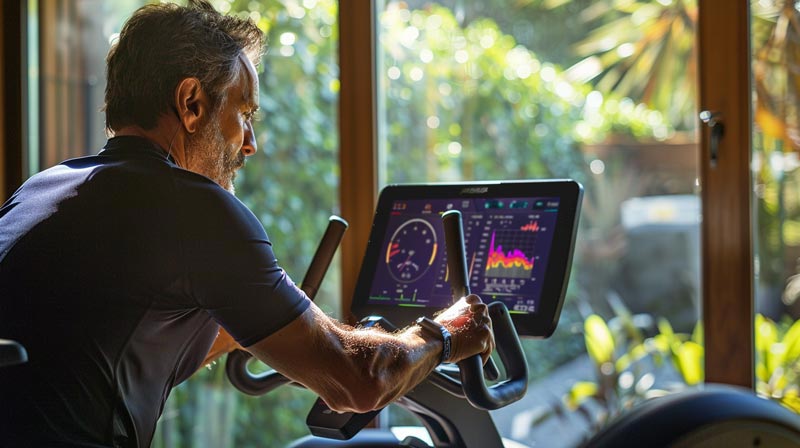Heart rate and nutrition in training form the foundation of effective fitness programmes and athletic performance. Reflecting on my recent experiences with heart rate monitoring and nutrition tracking, I was struck by how closely they aligned with professional strategies.
The BBC article about fuelling cyclists in the Tour de France sparked my interest in exploring this connection further. It revealed insights that extend far beyond elite sports.
From March 2024, I wore a continuous glucose monitor alongside my Garmin watch for three months. This provided a wealth of data on how my heart rate zones correlated with blood sugar levels and energy expenditure. This experiment opened my eyes to the intricate relationship between heart rate and nutrition in training. Many professional and amateur athletes are now leveraging to optimise their training.
Heart rate training has gained importance as a technique to explore the function of the autonomic nervous system. My personal observations during intense workouts and recovery periods echoed the scientific findings. Heart rate variability reflects the body’s ability to adapt to various stressors, including exercise and nutritional intake.
The concept of heart rate zones, which categorise exercise intensity based on percentages of maximum heart rate, proved invaluable in understanding my body’s fuel preferences and recovery needs. During lower-intensity workouts in zones 1 and 2, I noticed that my body primarily burned fat for fuel. Higher-intensity sessions in zones 4 and 5 relied heavily on carbohydrates. This knowledge allowed me to tailor my nutrition strategy to effectively support different training sessions.
Importantly, I discovered that heart rate and nutrition in training are intertwined with heart rate data, informing not just during exercise fuelling but also overall nutritional planning. On days when my heart rate variability was low, indicating potential fatigue or inadequate recovery, I found that adjusting my nutrient intake and focusing on recovery-promoting foods made a noticeable difference in my subsequent performance and well-being.
In the following sections, we’ll examine the science behind heart rate zones and explore how they impact nutritional needs. I will also discuss practical ways to apply this knowledge to enhance your training and overall health.
Whether you’re an experienced athlete or a fitness enthusiast, understanding the synergy between heart rate and nutrition can significantly improve your performance and help you achieve your health goals more effectively.
Understanding Heart Rate Zones
Heart rate zones are crucial for optimising training and nutrition. They provide a framework for understanding exercise intensity and its impact on the body. Let’s explore these zones and their significance in your fitness journey.
Firstly, let’s define critical terms:
- Resting Heart Rate (RHR): Your heart rate when completely resting.
- Maximum Heart Rate (MHR): The highest number of beats per minute your heart can safely achieve.
- Target Heart Rate Zones: Specific heart rate ranges used for training purposes.
Calculating Your Maximum Heart Rate
Understanding your maximum heart rate is the first step in effectively using heart rate zones for training. There are a couple of methods to estimate your MHR:
You first need to estimate your MHR to determine your heart rate zones. A simple formula is:
MHR = 220 – your age
However, for more accuracy, consider using the revised formula:
MHR = 208 – (0.7 x your age)
The Five Heart Rate Zones
Heart rate zones divide your heart rate range into five distinct intensity levels. Each zone serves a specific purpose in training and affects your body differently.
| Zone | Intensity | Percentage of MHR | Other Names | Benefits |
|---|---|---|---|---|
| 1 | Very Light | 50–60% | Warm-up, recovery, easy | Warm-up, recovery, improves overall health |
| 2 | Light | 60–70% | Aerobic, endurance, base, light | Enhances endurance, burns fat |
| 3 | Moderate | 70–80% | Tempo, threshold, cardio, moderate | Improves aerobic fitness |
| 4 | Hard | 80–90% | Lactate threshold, redline, hard | Increases maximum performance capacity |
| 5 | Maximum | 90–100% | Anaerobic, V02 max, peak, maximum | Develops maximum performance and speed |
Heart Rate Zones and Caloric Expenditure
The relationship between heart rate zones and caloric expenditure is crucial to heart rate and nutrition in training. Understanding how your body uses energy in each zone can help you tailor your nutritional strategy:
- Zones 1-2: Primarily burn fat for fuel, ideal for long, steady workouts.
- Zones 3-4: Utilise a mix of fat and carbohydrates, which improves overall fitness.
- Zone 5: Relies heavily on carbohydrates, best for short, intense bursts of activity.
Tailoring your workouts to specific heart rate zones can help you manage your energy expenditure and nutritional needs effectively. For instance, training in lower zones may require more fat-based nutrition. In contrast, high-intensity work in upper zones demands quick-acting carbohydrates.
Remember, heart rate and nutrition in training go hand in hand. Monitoring your heart rate during workouts can help you make informed decisions about your nutritional intake before, during, and after exercise.
The following section will explore how technology can help you leverage these heart rate zones for optimal training and nutrition planning.

Technology and Heart Rate and Nutrition in Training Monitoring
As mentioned earlier, technology is crucial in leveraging heart rate data for training and nutrition. Wearable devices have revolutionised how we monitor and interpret our body’s responses to exercise and diet.
Wearable Technology: Your 24/7 Health Companion
Devices like Garmin watches and Fitbit trackers have transformed heart rate monitoring from a sporadic activity to a continuous process. These gadgets provide round-the-clock insights into your heart rate and nutrition in training, offering a comprehensive view of your body’s responses.
Key features of modern wearable devices include:
- Continuous heart rate monitoring
- Sleep tracking
- Stress level assessment
- Activity tracking
- Calorie expenditure estimation
Harnessing Data for Optimal Performance
The wealth of data from these devices allows for precise adjustments to your training and nutrition strategy. Here’s how:
- Heart Rate Variability (HRV) Tracking: Many devices now measure HRV, a key indicator of recovery and training readiness. By monitoring your HRV, you can make informed decisions about training intensity and nutritional needs.
- Adaptive Training Plans: Some advanced devices use your heart rate data to adjust your training plan automatically, ensuring you’re always working at optimal intensity.
- Real-time Feedback: During workouts, these devices provide instant feedback on your heart rate zone, allowing you to adjust your effort to meet your training goals.
Nutrition Insights Through Heart Rate Data
Wearable technology doesn’t just inform your training; it also provides valuable insights for nutrition planning:
- Calorie Expenditure: By accurately tracking your activity and heart rate, these devices can estimate your daily calorie burn, helping you tailor your nutritional intake.
- Recovery Monitoring: Post-exercise heart rate recovery data can indicate when your body needs additional nutritional support for optimal recovery.
- Glucose Monitoring: Some advanced systems, like continuous glucose monitors, can be paired with heart rate data to provide a comprehensive view of how your nutrition affects your performance.
Case Study: My Experience with Garmin and Continuous Glucose Monitoring
I used a Garmin watch and a continuous glucose monitor for three months. This combination provided invaluable insights into how my heart rate and nutrition in training interacted.
For instance, I noticed that high-intensity sessions in heart rate zones 4 and 5 led to rapid glucose depletion, necessitating quick-acting carbohydrates for recovery. Conversely, longer, lower-intensity workouts in zones 1 and 2 allowed for more stable glucose levels, informing a different nutritional strategy.
This technology-enabled approach allowed me to fine-tune my nutrition based on real-time physiological data, improving performance and recovery.
Heart Rate and Nutrition in Training
Understanding the intricate relationship between heart rate and nutrition in training is crucial for optimising athletic performance. This connection goes beyond simply eating more when you exercise harder; it’s about fine-tuning your nutritional intake based on precise physiological data.
Determining Caloric Needs Through Heart Rate Data
Heart rate data provides valuable insights into energy expenditure, allowing for accurate estimation of caloric needs. Here’s how:
- Resting Metabolic Rate (RMR): Your heart rate at rest helps estimate your RMR, the number of calories your body burns at rest.
- Exercise Energy Expenditure: During exercise, your heart rate correlates with oxygen consumption, which is directly related to calorie burn.
- Excess Post-exercise Oxygen Consumption (EPOC): Elevated heart rate post-exercise indicates additional calorie burn during recovery.
Combining these factors, wearable devices provide a comprehensive picture of your daily caloric needs for training and rest days.
Macronutrient Breakdown Based on Heart Rate and Activity Level
Different heart rate zones and activity levels demand varying macronutrient ratios for optimal performance:
- Lower Heart Rate Zones (1-2): These primarily utilise fat for fuel. A diet higher in healthy fats can support prolonged activity in these zones.
- Middle Heart Rate Zones (3-4): These zones use a mix of carbohydrates and fats. A balanced diet with moderate carbohydrates and fats is ideal.
- High Heart Rate Zones (4-5): These zones heavily rely on carbohydrates. A diet rich in complex carbohydrates supports high-intensity efforts.
Personalised Nutrition Plans: Lessons from Professional Cycling
The Tour de France provides an excellent case study in personalised nutrition based on heart rate data. As detailed in the BBC article, professional cycling teams use sophisticated methods to tailor each rider’s diet:
- Pre-race Fuelling: Riders consume carbohydrate-rich meals before stages, adjusting portions based on the anticipated heart rate zones they’ll be working in.
- During-race Nutrition: Soigneurs provide riders with specific foods and drinks based on real-time heart rate data, ensuring optimal fuelling for the current physiological demand.
- Recovery Nutrition: Post-stage meals are customised based on the day’s effort, as indicated by time spent in different heart rate zones.
One EF Education-EasyPost rider, for instance, consumed four tubs of maple syrup during the three-week race, demonstrating the high carbohydrate demands of sustained high-intensity effort.
Practical Application for Everyday Athletes
While we may not have a team of nutritionists at our disposal, we can apply these principles to our training:
- Use heart rate data to estimate daily caloric needs.
- Adjust macronutrient intake based on planned workouts’ intensity (heart rate zones).
- Pay attention to post-exercise heart rate recovery to guide recovery nutrition.
Remember, heart rate and nutrition in training are deeply interconnected. We can make informed decisions about our nutritional needs by leveraging heart rate data, leading to improved performance and recovery.

Heart Rate Variability (HRV) and Recovery
Heart rate variability (HRV) is a powerful tool in an athlete’s arsenal. It offers insights into recovery and guides nutritional strategies. Let’s examine this fascinating aspect of heart rate and nutrition in training.
What is Heart Rate Variability?
HRV is the variation in time between consecutive heartbeats, unlike heart rate, which counts the number of heartbeats per minute. HRV focuses on the subtle changes in the intervals between beats.
These variations reflect the balance between the autonomic nervous system’s sympathetic (‘fight or flight’) and parasympathetic (‘rest and digest’) branches.
Significance in Assessing Recovery
HRV provides a window into your body’s stress levels and performance readiness. Here’s why it matters:
- Higher HRV generally indicates better recovery and adaptability.
- Lower HRV may suggest accumulated stress or inadequate recovery.
- Daily HRV tracking can help optimise the training load and prevent overtraining.
HRV and Post-Exercise Nutrition
Understanding your HRV can significantly influence your post-exercise nutrition strategy:
- High HRV: Indicates good recovery. Focus on regular refuelling without extra emphasis on recovery nutrients.
- Low HRV: Suggests incomplete recovery. Consider increasing intake of: • Antioxidant-rich foods to combat exercise-induced oxidative stress • Protein for muscle repair • Complex carbohydrates to replenish glycogen stores.
- Consistently Low HRV: May indicate a need for a more comprehensive recovery strategy, including • Increased focus on anti-inflammatory foods • Potential supplement use (under professional guidance) • Emphasis on sleep quality and stress management.
Practical Application of HRV in Training and Nutrition
To effectively use HRV in your training and nutrition plan:
- Monitor your HRV consistently, preferably first thing in the morning; my Garmin watch provides a daily report.
- Look for trends rather than day-to-day fluctuations.
- Use HRV data to guide both training intensity and nutritional focus.
For example, on days with lower HRV, you might opt for a lighter training session and emphasise recovery-focused nutrition. Conversely, when HRV is high, you could tackle more intense workouts and focus on performance-oriented nutrition.
While HRV is a powerful tool, it’s just one piece of the puzzle. Combine HRV insights with other metrics and your subjective feelings for a comprehensive approach to heart rate and nutrition in training.
Practical Applications for Everyday Athletes
Leveraging heart rate and nutrition in training isn’t just for elite athletes. In fact, everyday fitness enthusiasts can significantly benefit from this approach. Understanding and applying heart rate data optimise your training and nutrition strategies for better performance and recovery.
Firstly, it’s crucial to understand that your heart rate data provides a window into your body’s state. This information can guide not only your workout intensity but also your nutritional needs. For instance, consistently high resting heart rates indicate a need for more recovery-focused nutrition and lighter training sessions.
Here are some practical tips to help you use heart rate data effectively:
- Establish your baseline: • Record your resting heart rate first thing in the morning for a week • Note your maximum heart rate during high-intensity workouts • Use these to calculate your heart rate zones.
- Monitor your heart rate during workouts: • Stay in lower zones (1-2) for endurance-building sessions • Hit higher zones (4-5) for intense, performance-boosting workouts • Adjust your effort based on real-time heart rate feedback.
- Use heart rate data to inform nutrition: • Fuel with complex carbs before high-intensity (high heart rate) sessions • Consume protein and simple carbs immediately after high heart rate workouts • On days with lower average heart rates, focus on nutrient-dense, lower-calorie foods.
- Interpret recovery data: • Track your heart rate variability (HRV) over time • Lower HRV may indicate a need for more recovery-focused nutrition • Higher HRV suggests your body is ready for more intense training.
Make informed decisions: • Use trends in your heart rate data to adjust your training plan • Align your meal planning with your anticipated training intensity • Listen to your body in conjunction with the data from your wearable device.

The Central Role of Heart Rate and Nutrition in Training
In this post on heart rate and nutrition in training, we’ve uncovered the relationship between our body’s rhythms and fuel requirements. The synergy between these two elements forms the bedrock of practical training and optimal performance.
From understanding heart rate zones to leveraging cutting-edge technology, we’ve seen how heart rate data can inform every aspect of our fitness journey. This information is about the numbers on a screen and our body’s state, offering invaluable insights for tailoring our nutrition and training strategies.
The power of heart rate monitoring extends far beyond elite athletes. Everyday fitness enthusiasts can harness this data to fine-tune their workouts and nutritional intake. By paying attention to heart rate variability, we gain a deeper understanding of our recovery needs and can adjust our nutrition accordingly.
Moreover, the relationship between heart rate and nutrition in training is dynamic and highly individual. What works for one person may not work for another, underlining the importance of personal experimentation and consistent monitoring. This approach allows for a genuinely personalised fitness programme that evolves with our changing needs and goals.
The potential for even more precise and actionable insights grows as wearable technology advances. These tools empower us to make informed decisions about our training intensity, recovery strategies, and nutritional needs, resulting in a more efficient, effective, and enjoyable fitness journey.
Ultimately, the central role of heart rate and nutrition in training cannot be overstated. Embracing this connection opens the door to enhanced performance, faster recovery, and improved overall well-being. As we deepen our understanding of this relationship, we unlock new possibilities for optimising our health and fitness.
Sources
- Ben Bloom. 2 July 2024. Fuelling the Tour de France: Secrets of the team kitchens. BBC
- Helgerud J, Høydal K, Wang E, et al. Aerobic high-intensity intervals improve VO2 max more than moderate training. Med Sci Sports Exerc. 2007;39(4):665-71.
- Kiviniemi AM, Hautala AJ, Kinnunen H, et al. Endurance training is guided individually by daily heart rate variability measurements. Eur J Appl Physiol. 2007;101(6):743-751.
- McMillan DE. Interpreting heart rate variability sleep/wake patterns in cardiac patients. J Cardiovasc Nurs. 2002;17(1):69-81.
- Plews DJ, Laursen PB, Stanley J, et al. Training adaptation and heart rate variability in elite endurance athletes: opening the door to effective monitoring. Sports Med. 2013;43(9):773-781.
- Saalasti S. Neural networks for heart rate time series analysis. PhD Thesis. Finland, Jyväskylä Studies in Computing 33, Jyväskylä: Department of Mathematical Information Technology; University of Jyväskylä; 2003.
Vanderlei LCM, Pastre CM, Hoshi RA, et al. Basic notions of heart rate variability and its clinical applicability. Rev Bras Cir Cardiovasc. 2009;24(2):205-217.



